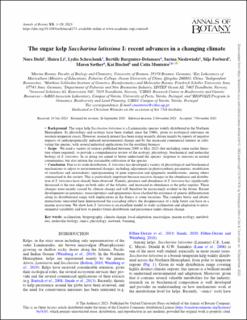| dc.contributor.author | Diehl, Nora | |
| dc.contributor.author | Li, Huiru | |
| dc.contributor.author | Scheschonk, Lydia | |
| dc.contributor.author | Burgunter-Delamar, Bertille | |
| dc.contributor.author | Niedzwied, Sarina | |
| dc.contributor.author | Forbord, Silje | |
| dc.contributor.author | Sæther, Maren | |
| dc.contributor.author | Bischof, Kai | |
| dc.contributor.author | Monteiro, Cátia | |
| dc.date.accessioned | 2024-01-12T13:12:41Z | |
| dc.date.available | 2024-01-12T13:12:41Z | |
| dc.date.created | 2023-12-19T14:09:16Z | |
| dc.date.issued | 2023 | |
| dc.identifier.citation | Annals of Botany. 2023, 1-29, mcad173. | en_US |
| dc.identifier.issn | 0305-7364 | |
| dc.identifier.uri | https://hdl.handle.net/11250/3111327 | |
| dc.description.abstract | • Background: The sugar kelp Saccharina latissima is a Laminariales species widely distributed in the Northern Hemisphere. Its physiology and ecology have been studied since the 1960s, given its ecological relevance on western temperate coasts. However, research interest has been rising recently, driven mainly by reports of negative impacts of anthropogenically induced environmental change and by the increased commercial interest in cultivating the species, with several industrial applications for the resulting biomass. • Scope: We used a variety of sources published between 2009 to May 2023 (but including some earlier literature where required), to provide a comprehensive review of the ecology, physiology, biochemical and molecular biology of S. latissima. In so doing we aimed to better understand the species’ response to stressors in natural communities, but also inform the sustainable cultivation of the species. • Conclusion: Due to its wide distribution, S. latissima has developed a variety of physiological and biochemical mechanisms to adjust to environmental changes, including adjustments in photosynthetic parameters, modulation of osmolytes and antioxidants, reprogramming of gene expression and epigenetic modifications, among others summarized in this review. This is particularly important because massive changes in the abundance and distribution of S. latissima have already been observed. Namely, presence and abundance of S. latissima has significantly decreased at the rear edges on both sides of the Atlantic, and increased in abundance at the polar regions. These changes were mainly caused by climate change and will therefore be increasingly evident in the future. Recent developments in genomics, transcriptomics and epigenomics have clarified the existence of genetic differentiation along its distributional range with implications in the fitness at some locations. The complex biotic and abiotic interactions unraveled here demonstrated the cascading effects the disappearance of a kelp forest can have in a marine ecosystem. We show how S. latissima is an excellent model to study acclimation and adaptation to environmental variability and how to predict future distribution and persistence under climate change. | en_US |
| dc.language.iso | eng | en_US |
| dc.publisher | Oxford University Press | en_US |
| dc.rights | Navngivelse 4.0 Internasjonal | * |
| dc.rights.uri | http://creativecommons.org/licenses/by/4.0/deed.no | * |
| dc.title | The sugar kelp Saccharina latissima I: recent advances in a changing climate | en_US |
| dc.title.alternative | The sugar kelp Saccharina latissima I: recent advances in a changing climate | en_US |
| dc.type | Peer reviewed | en_US |
| dc.type | Journal article | en_US |
| dc.description.version | publishedVersion | en_US |
| dc.rights.holder | © The Author(s) 2023. Published by Oxford University Press. | en_US |
| dc.source.pagenumber | 29 | en_US |
| dc.source.journal | Annals of Botany | en_US |
| dc.identifier.doi | 10.1093/aob/mcad173 | |
| dc.identifier.cristin | 2215671 | |
| dc.source.articlenumber | mcad173 | en_US |
| cristin.ispublished | true | |
| cristin.fulltext | original | |
| cristin.qualitycode | 1 | |

